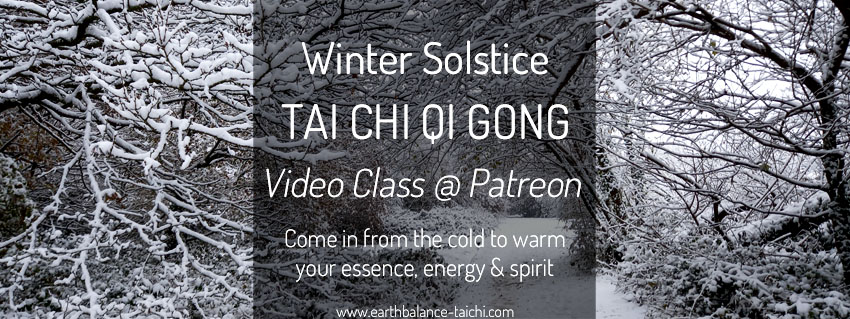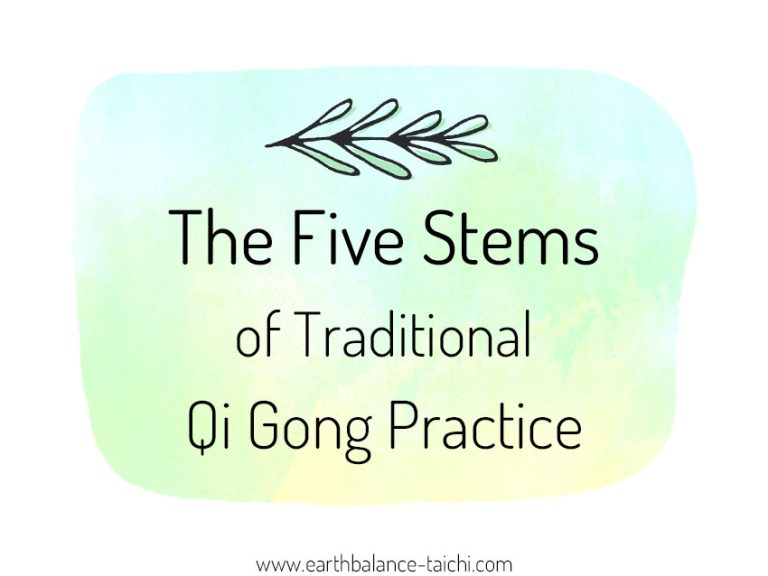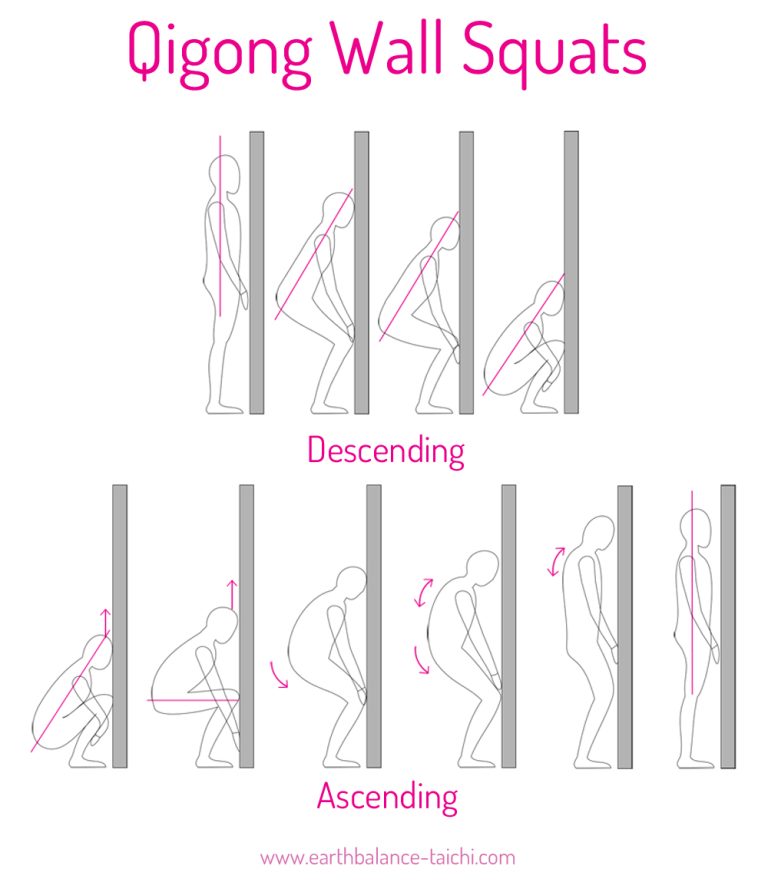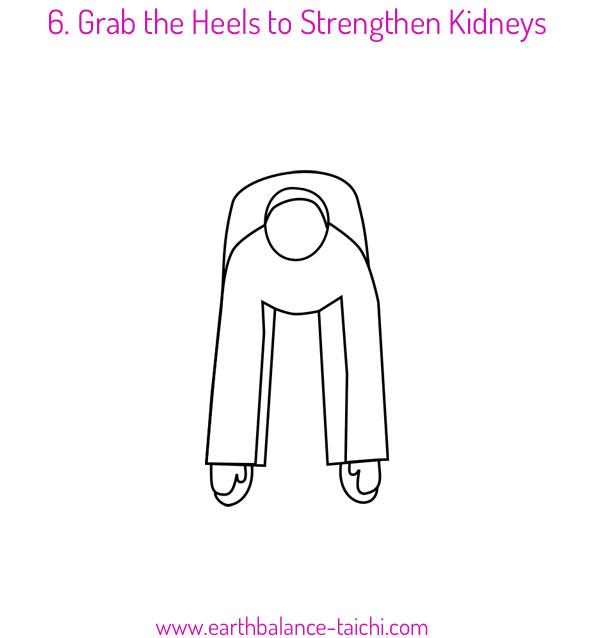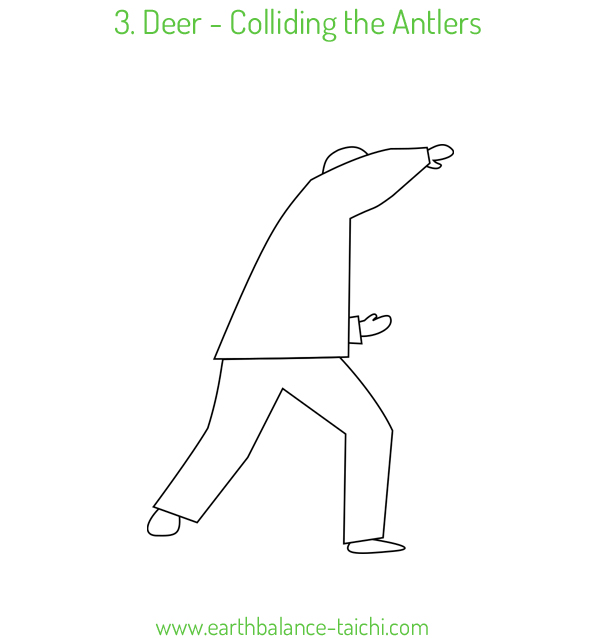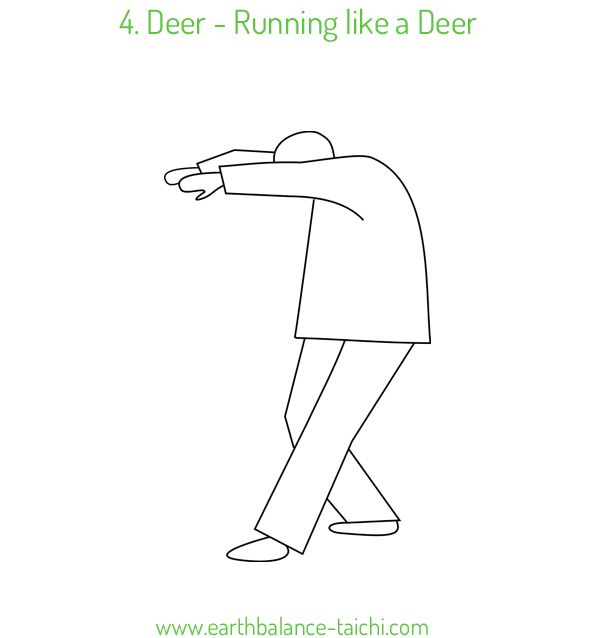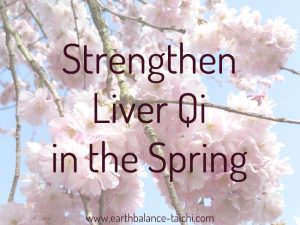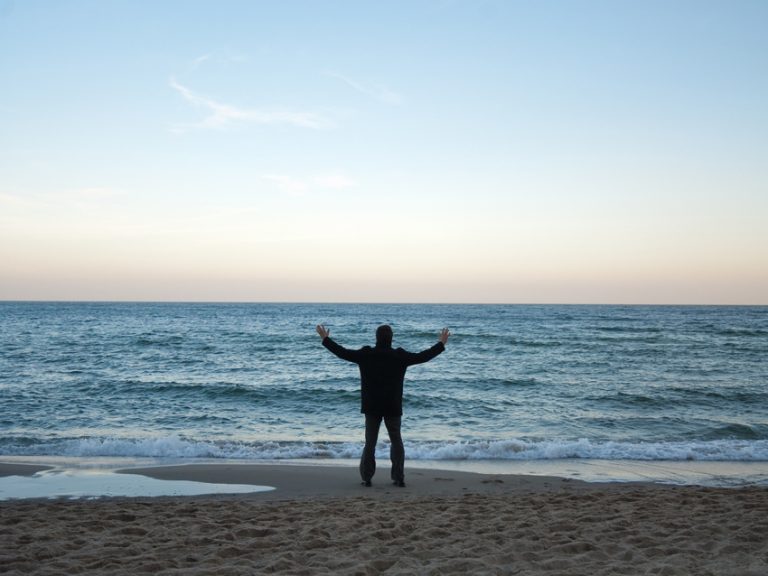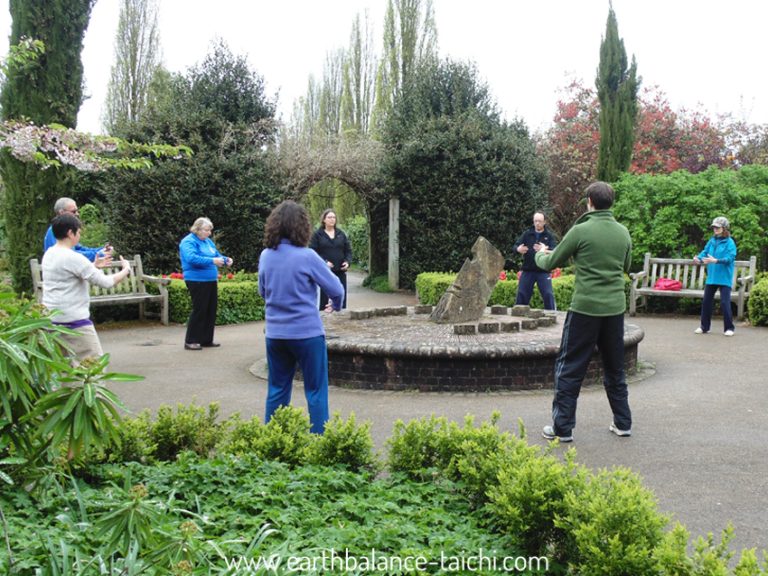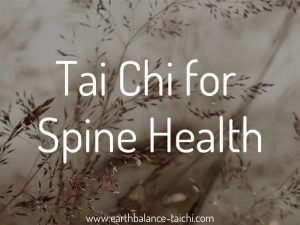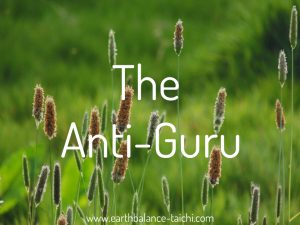Winter Qi for the Kidneys

Winter Qi for the Kidneys
Winter is yin by nature, a time for consolidating, stillness and retreating within. It is a dark, cold, wet and icy time. The winter solstice is seen as absolute yin, with the tiniest spark of light within. It is easy for our vitality to become depleted in this season, as our bodies go into hibernation mode. Winter is governed by the water element and the kidneys in Traditional Chinese Medicine (TCM). Here are my suggestions for strengthening your kidneys in the cold winter time. Read more about Winter Qi for the Kidneys.
The kidneys are a yin organ, and are seen as the most yin of all the yin organs. They are paired with the bladder, a yang organ. The kidney meridian channel travels from the centre of the foot up to the chest. The bladder meridian channel travels from the eyes up and over the head and down to the little toe. It is the longest meridian channel in the body.
Winter Qi for the Kidneys - Emotions
The kidneys in Traditional Chinese Medicine are associated with the following emotions:
- Positive: Gentleness, generosity, calmness, silence
- Negative: Fear, isolation, insecurity
Rather than the emotions relating to a psychological brain state, in Traditional Chinese Medicine the kidneys are associated with specific emotions. To bring these emotions into balance, the kidneys are supported and strengthened using the five element theory.
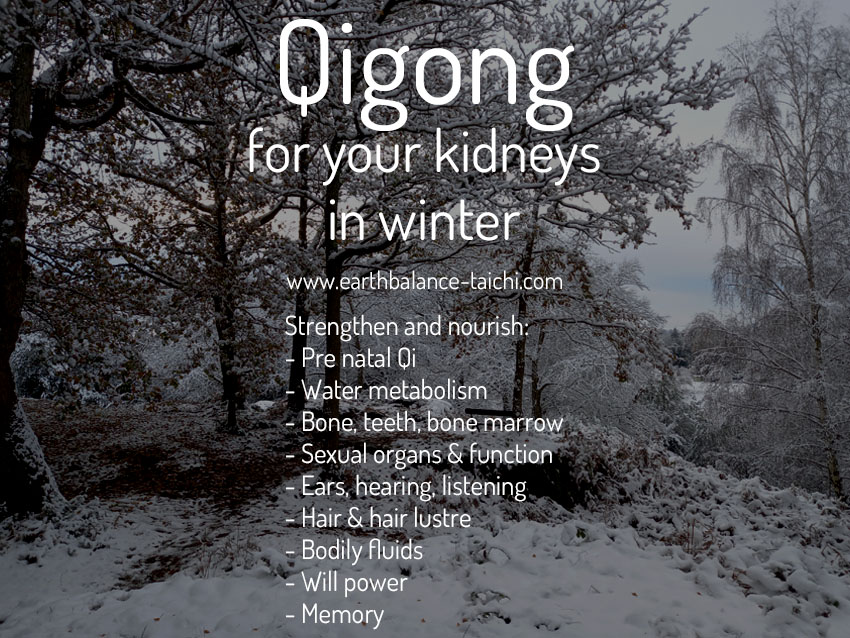
Taoist associations with the kidneys
| Five Element Theory | The Water Element |
|---|---|
| Number | 1 |
| Associations | Quiet, Cool, Floating, Stillness, Hibernation, Communication, Transmission of ideas |
| Season | Winter |
| Time | Midnight |
| Direction | North |
| Celestial Animal | Turtle |
| Yin or Yang | The root of both yin and yang |
| Time of Day | 5-7pm |
| Movement | Descending |
| Power | Consolidation |
| Flavour | Salty |
| Sound | Suck |
| Weather | Rainy, Wet |
| Climate | Cold |
| Age | Old age |
| Stage of Life | Death |
| Form | Flowing, Curved, Wavy, Soft lines, Irregular, Asymmetrical, No fixed shape, Eclectic shape |
| Colours | Black, Navy, Midnight Blue, Dark Blue, Dark Indigo, Charcoal, Grey |
| Yin (Feminine) | Stream |
| Yang (Masculine) | Ocean |
The 5 Element Cycles and Relationships
The kidneys are the water element in Traditional Chinese Medicine. In the five element theory, the other four elements interact with the water element. The concept of the five elements is to bring everything back into balance, each coexisting without dominance. The following graphic looks at the relationship and cycles between wood, fire, earth, water and metal.

A Doctor of Traditional Chinese Medicine would determine which of the five elements could be utilised to help strengthen, weaken, control or regulate the water element. An example would be if the water element was deficient, then the metal element would be used to support and the water element would be used to strengthen. If the water element was too strong, then the wood element would be used to drain, or the earth element would be used to regulate.
TCM Functions
The kidneys and bladder system in TCM includes the testicles in men and the ovaries in women. Together they are responsible for a variety of functions:
- Pre-natal qi (jing) is stored in the kidneys, inherited from our parents. When there is an abundance of jing this creates a strong and healthy constitution, vitality and a resilient immune system.
- Water metabolism.
- Sexual and reproductive organs and function.
- Sensory organ: The ears, hearing and listening.
- Tissue: Bones, teeth and the production of bone marrow.
- Skeletal structure.
- The spinal cord and the brain are seen as extensions of the bone marrow.
- Hair and hair lustre.
- Regulates the orifices (bladder and anus).
- Responsible for bodily fluids; urine, vaginal fluids and semen.
- Will power.
- Memory.
Potential symptoms stemming from a deficient kidneys in Traditional Chinese Medicine:
- Brittle bones, osteoporosis, congenital developmental issues.
- Kidney stones.
- Tooth decay, loose teeth.
- Ears ringing, buzzing, humming, tinnitus.
- Sticky ears, over production of ear wax, ear infections.
- Hearing loss, deafness, hearing loss as we age shows the ebbing away of our kidney vitality.
- Low energy, chronic fatigue.
- Lower back pain.
- Weak knees.
- Brian fog, absent-mindfulness, forgetfulness, memory loss.
- Excessive thirst.
- Hair loss.
- Excessive urination, bladder infection, problems with urinating, urinary incontinence.
- Prostate infections.
- Menstrual and menopausal problems.
- Loss of sexual appetite, infertility, premature ejaculation, impotence, vaginal dryness.
- Hates the cold, feels cold.
- Vertigo, feeling faint.
- Headaches.
- Vision problems.
Warm the kidneys:
- In the cold weather, keep the kidneys warm by wrapping up in warm clothing, and ensure that your lower back is not exposed to the cold.
- Use a hot water bottle on your lower back.
- Traditionally in China, when training Tai Chi out in the snow, it was common for a hot water bottle to be held against the kidneys by tying a scarf around the waist.
There are many different types of kidney and adrenal deficiency within Traditional Chinese medicine, associated with the five element theory and the meridian channels.
The Five Stems Video Course
Interested to know more about Qigong? Learn about the five stems of traditional learning here. Join my FREE five day mini video course available to newsletter subscribers via this link.
Winter Qi for the Kidneys - Movement
To nourish your kidneys with exercise, look for slow and deliberate movements that help to open the lower and middle back, specifically the ming men point in TCM, which is where the kidneys sit between. You can also stimulate the kidney/bladder meridian channels or acupuncture points e.g. bubbling well in the centre of the foot (KD1 on the kidney meridian). In Tai Chi and Qigong the spine goes through a lengthening, flexing and extending motion with gentle expanding and compressing to massages the internal body. This helps increase blood flow, remove toxins and helps improve the function of the kidneys. The following exercises help strengthen the kidneys in Traditional Chinese Medicine.
- Health: Deep internal movement that massages the whole body.
- TCM: Stimulates the kidney and adrenal organs, opens the ren and du meridian channels.
- Movement: A deep squatting motion with a straight spine with the nose and toes up to a wall, from the base of the squat the spine is curved and waves towards upright.
Kidney Movement in 8 Pieces of Brocade Qigong
6. Two Hands Hold the Feet
- Health: Strengthens waist, stretches spine.
- TCM: Stimulates the kidneys.
- Movement: Start with the palms raised above the shoulders. Lower the palms down with the fingertips pointing to each other until they reach under the chest. Move the palms under the armpits with the thumbs on the side of the ribs. Push the palms down the back, when the palms reach the lower back / buttocks, forward bend with a straight spine / straight legs (micro bend) whilst the palms rub down the legs to the ankles. Place the palms on top of the shoes. Look forwards and push the arms forwards until they are parallel to the floor. Tilt the pelvis under to give momentum to raise up to standing.
- Spine involvement: The spine stays straight as it stretches away from the hips through the crown, with a forward bend (flexion) towards a relaxed spine at the base of the movement.
Kidney Movements in Five Animals Qigong
Colliding the Antlers
- Organ: Nourish and strengthen the kidneys by stretching around the waist and lower back.
- TCM: Nourish and balance Qi in the Du mai (governor meridian) and Ren mai (conception meridian). Activate yang Qi.
- Health: Side flexion and extension and rotation of the spine. Strengthens the lower back and waist muscles.
Running like a Deer
- Organ: Nourish and strengthen the kidneys by stretching around the waist and lower back.
- TCM: Open and stimulate Ming Men (DU-4). Nourish and balance Qi in the Du mai (governor meridian). Stimulate qi in the 3 yin and 3 yang meridian channels in the wrist/hand to aid the neck and shoulders. Activate yang Qi.
- Health: Flexion and extension of the spine. Spiralling rotation of the shoulders and arms. Strengthens and relaxes the neck, shoulders, waist and spine.
Kidney Movement in Earth Qigong for Women
Deer Walk I and II
TCM: Brings qi and blood into the kidneys, abdominal, lower back and pelvic area. Reduces symptoms of deficient kidneys. Increases female energy.
Health: Aids symptoms of menstruation and menopause. Improves sexual health and bladder control.
Key Movements I: Lengthening of the spine, rotation of the pelvis, pelvic floor contractions and deer eye exercises.
Key Movements II: Lengthening of the spine, opening of the lower back, stimulation of the ST36 acupuncture point for longevity.
Kidney Movement in Earth Qigong for Women
Crane Dance
TCM: Brings qi and blood into the kidneys, abdominal, lower back and pelvic area. Reduces symptoms of deficient kidneys.
Health: Relief from lower back pain. Opens the hip joints, increases range of motion. Balance and fall prevention training.
Key Movements: The pose is performed on one leg, connecting the lower back to the heel through a gentle expansion and lengthening motion.
Winter Qi for the Kidneys - Stillness
To nourish your kidneys through meditation, there are a variety of ways to practice. From breathing techniques where you imagine breathing in colour and emotions to the healing sounds. The following practices will help to nourish and strengthen the kidneys and bladder.
Dantian Breathing
TCM: Stimulate the acupuncture point 'ming men' opposite the navel, called the gate of life, responsible for the function of the kidneys.
Health: Spherical expansion and compression of the lower dantian, organs and subtle flexion of the lumbar spine.
Key Movements: The lower back and the lower abdomen expand on inhaling, and they both relax on exhaling. The majority of the physical movement is within the area between the pubic bone and the lower ribs, as the soft tissue has room to expand. The spine can flex and extend gently with the breath. This movement helps the lower back area expand and widen across the body, which includes the physical kidneys and the ming men acupuncture point.
The Inner Smile for the Kidneys
Hand Position:
- With palms facing your body, cover your kidney area on each side with each hand
Action:
- Draw an inner smile down to both kidneys and your adrenal glands just below your ribcage on the lower back.
- Fill the kidneys with the colour blue, inhaling a warm blue light into the kidneys.
- Breathe in the positive emotions of gentleness, generosity, calmness, silence.
- Fill the kidneys with light and thank them for the work they do.
- Breathe out the negative emotions of fear, isolation, insecurity.
- Dispersing these emotions into the clouds for recycling.
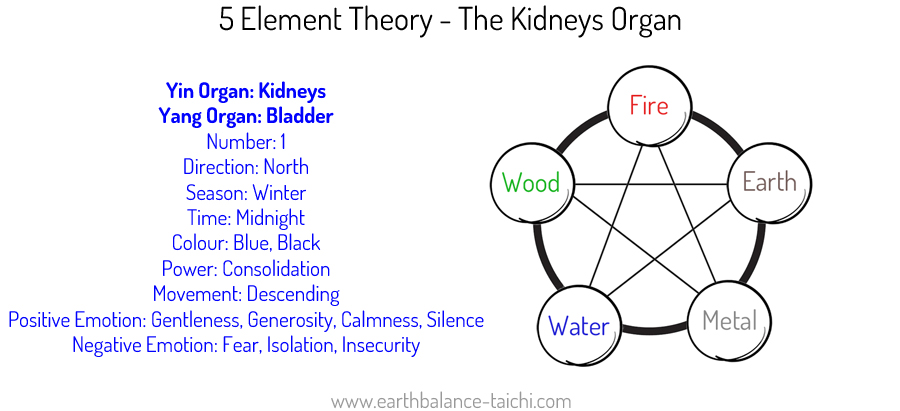
The Healing Sounds for the Kidneys
Hand Position:
- Start with hands resting on top of thighs, palms facing upwards.
- Bring the hands up to the kidneys.
- Lean forward and bring your hands together interlinking the fingers hugging the lower part of the knees, keep looking up whilst making sound.
Sound:
- Purse your lips into an ‘o’ and exhale ‘Choooooooo’, sounds like the word chew almost whispered
Zhan Zhuang / Standing Practice
Take you stillness meditation practice into an energising standing posture. Choose your pose, from embracing a tree stance to earth energy, all stances are welcome. Continue the inner smile practice to nourish and strengthen the kidneys by visualising breathing in the colour blue, or by breathing in a warm blue light into the kidney area on the lower back, recycling the emotions associated with the water element.
Kidney Foods
As the icy days of winter unfold, it is natural to want to eat foods that are warm and comforting. In Traditional Chinese Medicine, the kidneys and bladder are strengthened by the following foods:
- Water: H2O is essential for health, stay hydrated to support the kidneys.
- Salty foods e.g. miso.
- The addition of Celtic sea salt or Himalayan salt (do not over salt, in balance).
- Marrow bone broths.
- Hearty vegetable soups.
- Seafood: prawns, lobster, smoked fish, oysters, tuna, salmon.
- Tofu.
- Avocado.
- Black food: aubergine, plums, black grapes, black rice, black lentils, black garlic, black beans, black olives, blackberries, mulberry, elderberries, black currants, black sesame, seaweed, figs, raisins.
- Blue food: blueberries.
- Kidney shaped: kidney beans, any beans with a kidney shape.
- Walnuts.
- Brown rice and whole grains.
- Warming spices: cinnamon and cardamom.
Avoid
- Table salt.
- Unhealthy amount of any salt.
- Caffeinated coffee and tea.
- Alcohol.
- Processed foods.
- Sugar.
- Sweeteners.
- Over eating.
- Eating late at night.
Winter Qi for the Kidneys - Please speak with your doctor prior to starting a new exercise programme. This article is for information purposes only and must not be taken as medical advice.
